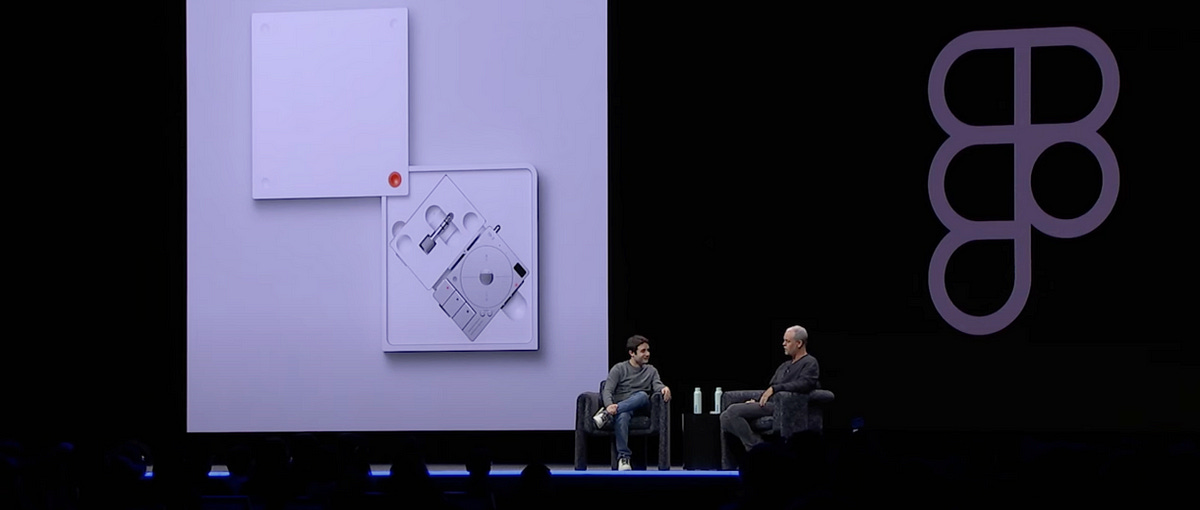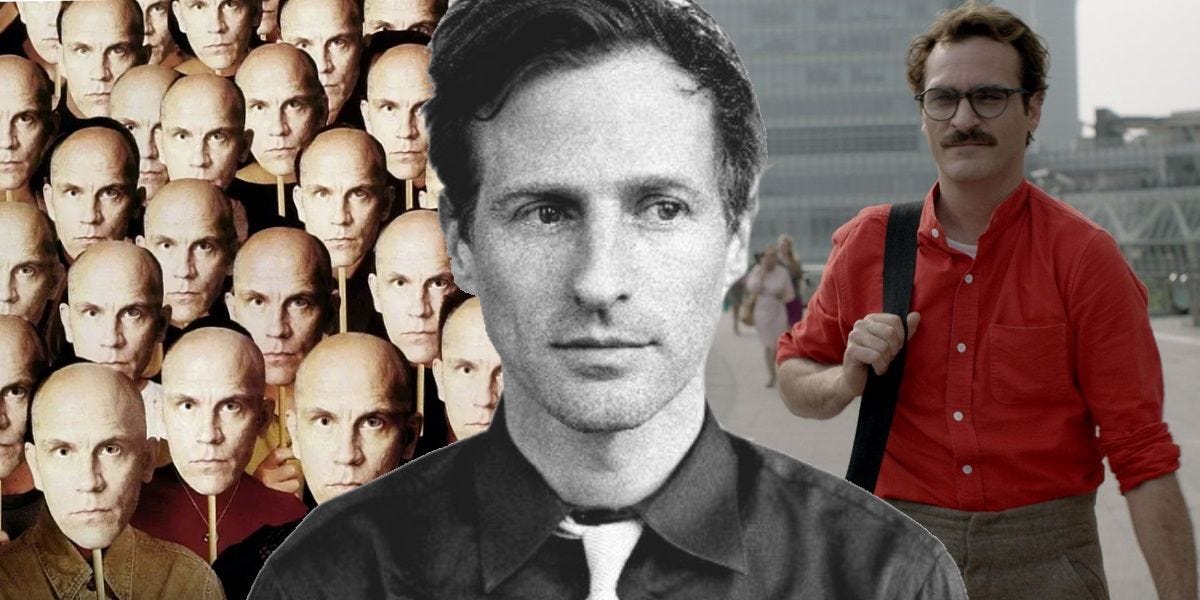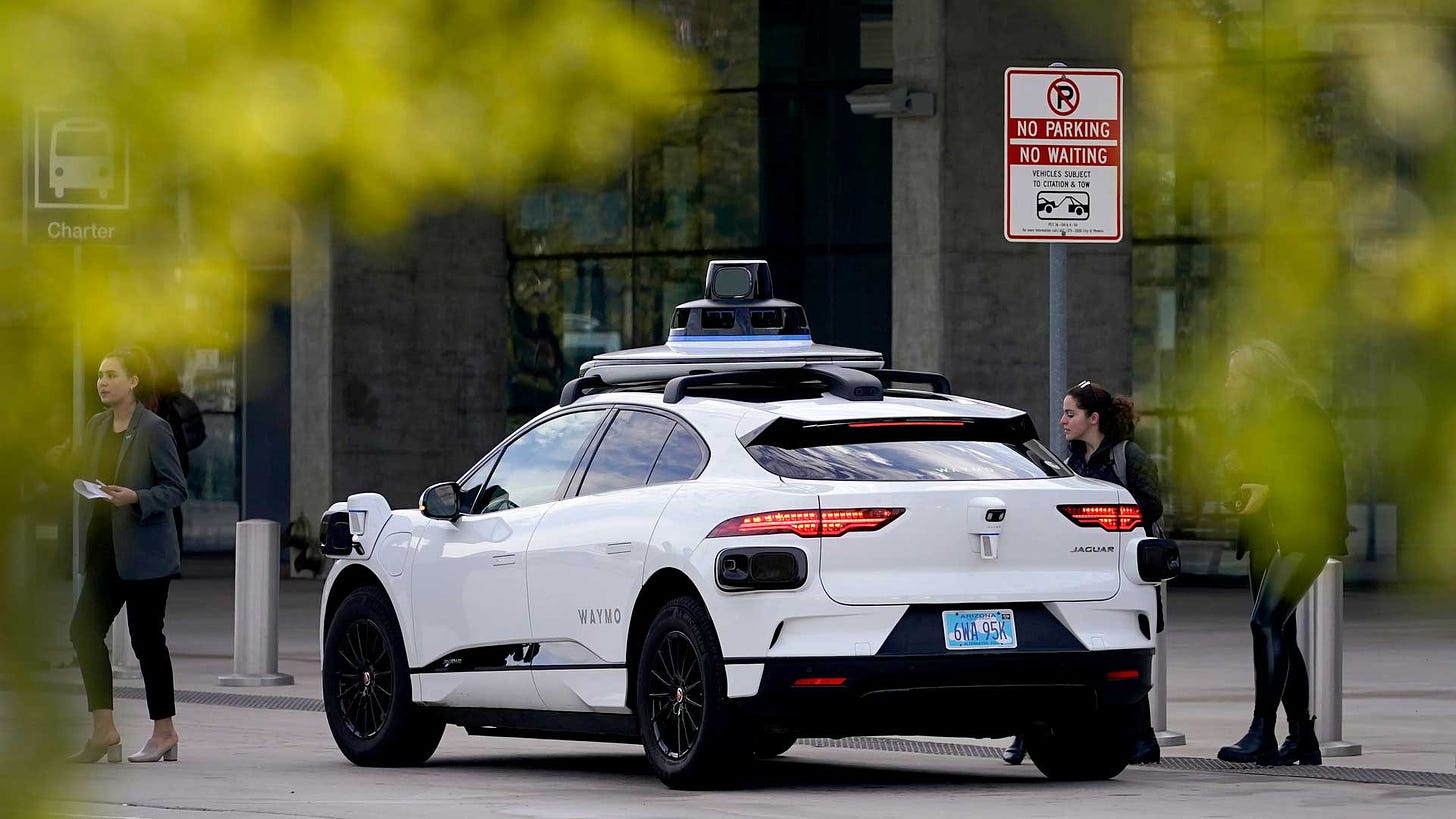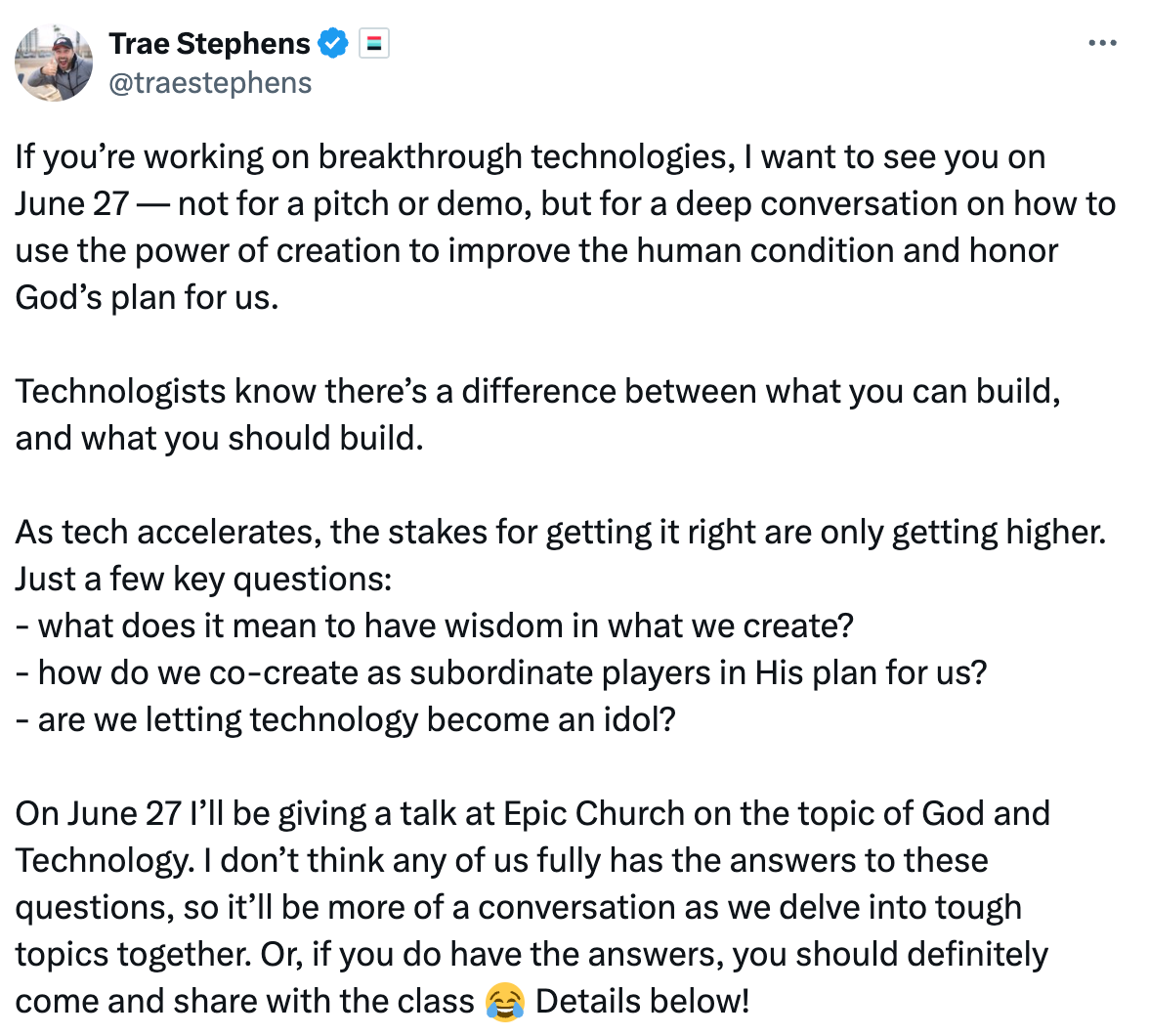This past week I was running around SF visiting friends, attending Config, celebrating my 29th birthday, and capping it with Trae Stephens’s talk “The Prologue and the Promise”.
CULTURE CLASH
I’ll start by saying that I didn’t find too much of Config that interesting. Maybe I did it wrong, which is entirely possible. But my gut feeling is that a 14,000 person conference can only be but so interesting if people aren’t ready to get very spicy.
Of course the audience, not the stage, is typically the point. And I had plenty of fun meeting folks and reconnecting with friends.
Perhaps the conversational affordance is only as expansive as the tool that’s pulling the culture together. Thus the consistent design in-joke of “we’re just moving rectangles around”.
I’ll say the quiet part out loud now.
The two big conversations I would say the majority of attendees were excited about were Jesper from Teenage Engineering & Spike Jonze the director of “Her”. Both conversations showed a community aspiring to those creative personalities, woefully out of their own depth.
Jesper & Dylan
Jesper tells a story about how he is currently working on designing a new type of organ. In preparation for this, he’s been playing an organ he bought, in his house… for the past 5 years.
Shortly later in conversation Dylan asks, “do you believe in user research?” To which Jesper immediately says, “uhh… no.”
MY BROTHER, DID YOU NOT HEAR THIS MAN’S PROCESS. THE RESEARCH IS FEELING WHAT IT’S LIKE TO PLAY AND LIVE WITH AN ACTUAL ORGAN FOR 5 YEARS. NOT TALK TO ORGANISTS AND SAY WHAT WOULD YOU CHANGE? IT COMES FROM WITHIN, IT COMES FROM REAL INTERACTION WITH THE OBJECT.
“If you design something, you need to know exactly why you do what you do. Otherwise it’s just styling.” — Jesper
The majority of the conversation was decently smooth, because Jesper generates his own energy. It wasn’t as much of a conversation as much as it was Dylan giving a question and letting Jesper go.
As a side note on holding public conversations. This is a preferred strategy when you have the right guest. The right guest can just go. Better to be silent and let them run.
The primary tension of the conversation rests in the clear schools that Dylan comes from compared to Jesper. And this is the point of this section, consciously select what school of thought you believe in and how that effects your style/team/outputs/etc.
Dylan and Figma at large is downstream of a matured software world. Figma is a condensing function of what design formed to be with an expanded web and clear mobile patterns. GK said this well while in conversation with Imran, it’s a relationship of software looping back on producing more software. And that forms clear borders. The problem is that there’s a border, and thus fertile soil for homogenization.
Compare that to Jesper and TE. Where the work is about fundamentally thinking about alternative form factors. That’s all you really have to say.
Relevant Lunch Conversation
Talking with Freddy about working on the first iPhone, he mentions they mocked things up in Adobe Illustrator because the tools we know today simply didn’t exist. The paradigms we celebrate came from orthogonal tools + close persistent collaboration across disciplines.
I’ve often talked about a collective need for folks to get post-Figma. Or at least to put that design tool in its right place within a larger process. It’s such a classic flaw. If all you have is a hammer, all you see are nails. If all you know is UI, then the majority of how you think about design is going to be moving UI around. And the systems will build scaffolding to maintain that truth, whether it’s helping you accomplish the real goals or not.
Return to this Jesper quote.
If you design something, you need to know exactly why you do what you do. Otherwise it’s just styling.
— Jesper Kouthoofd
Spike Jonze & Caterina Fake
There’s not much to say about this conversation because it was so brutal that I tweeted about it as soon as it ended.
Here’s the summary of the vibe (not direct quotes).
Caterina: “Her” has influenced so many people in AI. How did your team think about the interaction design and the device?
Spike: We weren’t thinking that way. It’s a film about love and loss and grief. I chatted with an AIM chatbot in 2004 and that’s why it’s an AI.
Caterina: So the AI…
Spike: This film is about my divorce from Sophia Coppola.
It was grossly clear that the singular goal from Caterina was to get a sound bite out of Spike on AI design. And it was equally clear that Spike did not think that way… AND that’s probably why the AI in the film is so aspirational. Because of how human Samantha actually was.
The most interesting part of the talk, when Spike really starts cooking…
Spike talks about working with his DP, Hoyte Van Hoytema, and their process of not what they would add from the film → but what they would take away. And how that removal would shape the tone and feel. For example, you never see a character wearing denim in the film.
Unfortunately, he get’s cutoff for the moderator’s continued sound bite search.
It’s tech inability to enjoy conversations on THAT level that blocks it from richer design landscapes. You invited Spike for what he did, not YOUR INTERPRETATION of what he did. Perhaps take a moment to actually learn about the process that produced the work that caused you to invite him to the main stage 10 years after its release.
One thing that I still struggle with is SF people’s general passiveness. When I was walking back into Config, there was a clearly disturbed guy standing directly at the door screaming at attendees. “YOU SHOULD BE ASHAMED ABOUT WHAT YOU’RE DOING.” Something always oddly prophetic strikes when you actually take a moment to listen to what’s being screamed around you… but that’s not the point.
Maybe it’s my New Yorker brain at work, but it takes a split second for that scene to turn into this screaming man deciding to punch a young lady wearing Issey Miyake in the face as she just tries to learn about design systems. All that security for no actual safety is just bizarre to me. Felt like a uniquely San Francisco scene.
WAYMO PROVES GOD’S PROMISE TO US. THE WAYMO PULLING UP TO TENT FILLED SIDEWALKS, SHOWS WE’RE HUMAN.
I’m not being hyperbolic, whenever I’m in a Waymo it feels like a gift from God. It’s the most magical tech experience I’ve had since last year demo’ing [REDACTED].
But as we all know, SF is struggling with its own speed. And it materializes in a painful human form. Folks that are so clearly in pain, and are living in it publicly.
There’s a unique lived reality of “the future is here, it’s just not evenly distributed” — when the Waymo drops you off next to two tents. An Uber driver would obviously stop short on the block or go to the corner, but the Waymo seeks accuracy. And a tent-home isn’t part of its calculation. Unfortunately it’s not part of the city’s calculation either.
The official programming of my trip ended at Epic Church, where Trae Stephens gave his talk titled “The Prologue and the Promise”. I would sum it up as an exploration of how to honor God’s plan for us as technologists, by going after good quests.
I met Trae super briefly at Hereticon two+ years ago. And I think I approached him a little too high energy, simply excited to know that he publicly professes to be a Christian and that it guides his relationship with work and investing. Which, if you follow this newsletter, you should know I think across the same lines.
The talk was incredible. Biblical examples of technological progress and how God used fallen individuals to still progress culture — Cain, after murdering his brother Abel goes on to build the first city. Woven with clear abstractions of Christian teachings that apply to how we think through forming our career path.
I believe that the talk was recorded, and I’m excited for it to hit Youtube (hopefully in the coming week or so).
Something that I think everyone, regardless of faith, can take away from what Trae spoke on → is the importance of true mission, freed from cycle trends.
“This is all one time historical.” Getting blown around in circles will have you feeling absolutely hopeless. I think a lot of tech folks are feeling that today. AI, Crypto, Creator, Consumer, MoSoCloudLo Silicon Valley-isms. Devoid of the anchoring of a real quest, the swarm can bring you anywhere they please.
There is a plan for your life. To contribute to the progress that can improve the quality of life for countless others. Doing that socially with friends and colleagues.
The question is → are you willing to let go of the false riches that continue to leave you hungry, for a different kind of journey?
I don’t do edits really, so excuse typos and things that don’t make sense.
Thanks so much for giving me your attention. I hope it was worth it, if not… unsubscribing will not hurt my feelings, and will give you back time you literally cannot have back.
Much love.
Live in the light







